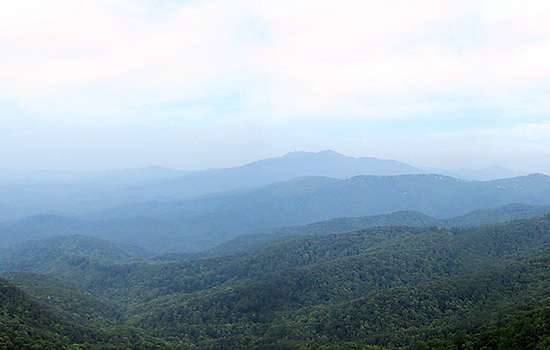How trees change the atmosphere

Rising from trees into the atmosphere, isoprene—a colorless, volatile, carbon-containing compound—smells vaguely like tires. It helped give the Blue Ridge Mountain range its name and has a profound effect upon the chemistry and composition of our atmosphere.
Scientists at Pacific Northwest National Laboratory wanted to find out how isoprene, after reacting with other substances called oxidants, is transformed into new carbon-containing particles called "secondary organic aerosol," or SOA, in the atmosphere.
Under conditions much like very remote forests, researchers found that isoprene was a factor of 2 or more efficient at producing particles than previously believed. They also found that nitrogen oxides, a common pollutant, affected those chemical reactions and subsequent particle production.
"Our work suggests that a more complex representation of SOA-forming reactions of isoprene, both with and without nitrogen oxides is necessary in climate models," said team lead and co-author Dr. John E. Shilling, an atmospheric scientist at PNNL. "These results will provide better representation of SOA formation in the pre-industrial atmosphere and in pristine regions of the world."
The bottom line: these all but invisible particles have a dramatic effect on Earth's climate and local air quality.
The haze hovering above the Blue Ridge Mountains of Virginia contains isoprene, reacting with other chemicals in the atmosphere to form particles. These particles give the haze its blue color. Yet isoprene's ubiquity belies our understanding of how it interacts with oxidants—substances that react with it—to form new and unique climate-affecting particles.
The PNNL research identified new compounds formed in the atmosphere by the aging—a.k.a. oxidation—of isoprene. The researchers propose a mechanism to explain these reactions that will expand knowledge about how this process happened in the pre-industrial atmosphere, and in remote and pristine regions of the globe that are today, far from human influence. The results also provide information for climate models about how nitrogen oxides, or NOx, exhausted from engines and other combustion processes, influences this process.
The research team oxidized isoprene under controlled laboratory conditions using a continuous-flow environmental chamber. Scientists use the chamber, located at PNNL, to understand atmospheric processes and SOA formation under controlled, reproducible conditions. They measured the gas- and particle-chemical composition in real time using advanced mass spectrometry techniques. They systematically varied these reaction conditions and measured the chemical products and organic particle yield as a function of these reaction conditions. When the team evaluated the measurements, they identified new products from the mass-spec data. The researchers then proposed a chemical mechanism to explain the formation of the products.
Under the reaction conditions that are traditionally recognized as not promoting the efficient formation of isoprene SOA, the team measured surprisingly high SOA mass yields that are factors of 2 or more, greater than those typically used in coupled chemistry climate models. With the presence of nitric oxide (NO), SOA yield was initially constant but then sharply decreased for input concentrations above 50 ppbv (parts per billion by volume). Online measurements of aerosol molecular composition showed that the fate of second-generation organic peroxy radicals is key to understanding the efficient SOA formation and the NOx-dependent yields described here and in the literature.
The researchers will integrate the new identification mechanism into atmospheric models to determine its atmospheric impact. In addition, they will repeat the experiments described here under a wider range of reaction conditions.
More information: Jiumeng Liu et al. Efficient Isoprene Secondary Organic Aerosol Formation from a Non-IEPOX Pathway, Environmental Science & Technology (2016). DOI: 10.1021/acs.est.6b01872
Journal information: Environmental Science & Technology
Provided by Pacific Northwest National Laboratory



















